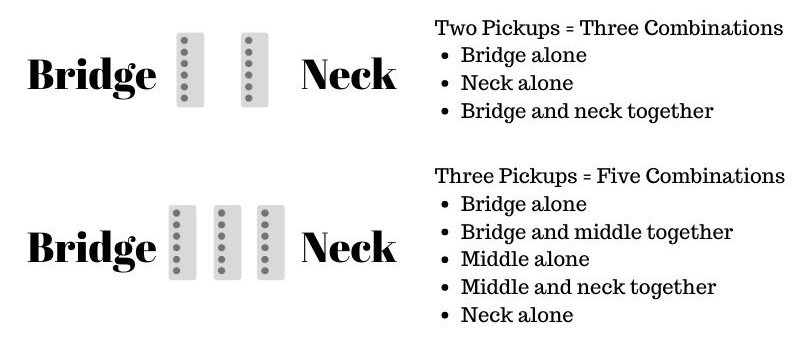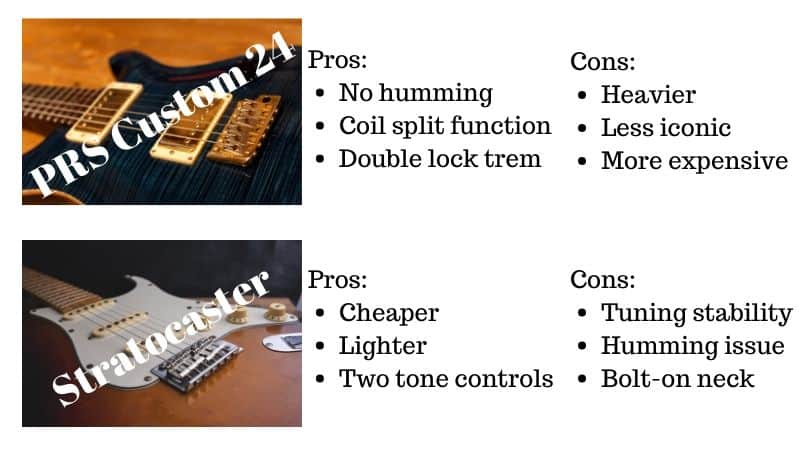A Quick Comparison
If you’re just interested in the specs, then check out the table below to compare all the key features between the standard versions of the Fender Stratocaster and PRS Custom 24 .
| Feature | PRS Custom 24 | Stratocaster |
| Body Shape | Double Cutaway, Contoured | Double Cutaway, Contoured |
| Body Wood | Mahogany | Ash or Alder |
| Pickups | Two Humbuckers | Three Single-Coils |
| Neck Shape | Wide-Thin | C-Shape |
| Neck Wood | Mahogany | Maple |
| Neck Construction | Set Neck | Bolt-On |
| Frets | 24 | 22 |
| Fretboard Wood | Rosewood | Rosewood or Maple |
| Scale Length | 25.0” | 25.5” |
| Bridge | Floating | Floating |
| Number of Tone Knobs | 1 | 2 |
| Weight | 8.5 pounds (3.9 kg) | 8 pounds (3.6 kg) |
Sound
The PRS Custom 24 and the Fender Stratocaster are very different sounding guitars. The PRS has a darker and warmer tone due to the humbucker pickups and mahogany tone wood. The Strat has single coil pickups and an alder or ash body usually, so sounds brighter and twangier in comparison.
The PRS does have a coil split function which gives you single-coil type sounds too, however, they’re a bit thinner sounding than traditional single coil pickups.
Both guitars have a tremolo arm, which gives you the option to change the pitch of the strings by bending or pulling on the arm to produce a unique sound.
Feel
Look
Key Differences
Now we’ve been through an overview of the specs, and the differences in terms of sound, look and feel, I’ll move onto the more specific differences in terms of the anatomy of each electric guitar.
Body
Neck
Pickups

Bridge
Price and Options
Next, we’ll move onto the different options and prices for each guitar. Starting with the Strat.
Fender is the original manufacturer and produces the higher-range guitars. Another company, call Squier produce the entry-level and affordable guitars. Squier is still owned by Fender though so you will get the true essence of the Strat even if you go for the cheaper option.
With the Fender and Squier Stratocaster ranges, you’ll get several different models. That’s where things get a bit more complicated. Here’s a quick rundown of the main lines.
- Squier Stratocasters: affinity, standard, classic vibe, contemporary.
- Fender Stratocasters: player, American professional, American Ultra/Elite, custom shop.
The PRS Custom 24 ranges are more straightforward. There are two main lines, the SE line and the USA core line. The USA core line is more premium, whilst the SE (student edition) line is produced in Korea and is a more affordable option.
- Squier Telecasters start at around $180 and go up to around $500. Fender Telecasters start from around $700 and go up to several thousand for a top of the range custom shop. The standard Fender Telecaster which costs roughly $1500.
- PRS SE Custom 24 electric guitars cost around $800 and the USA Core PRS Custom 24 costs around $3500-$4000.
Guitar Center are always the first place I look at when I’m interested in a new electric guitar because have a huge range of models for sale and always have some excellent deals on. Here’s a link to take you directly to Guitar Center’s electric guitar range so you can see all the offers available at the moment.
Frequently Asked Questions
Now you know all about each guitar, here are some FAQs that you may still have.
Which is best for a beginner?
Which is more versatile?
The Stratocaster and PRS Custom 24 are very versatile guitars. The Strat has thre pickups, giving you more tone options, whilst the PRS has a coil split function to give you single-coil type sounds as well as humbucker tones. In my opinion, the PRS is a bit more versatile due to this coil splitting function, but there’s not much between the two. It depends whether you prefer a warmer or darker tone as to which you’ll prefer.
which is easier to play?
Both the Stratocaster and PRS Custom 24 have fairly standard sized necks making them easy and quick to play on. There’s not much between the two in terms of playability but I would probably say the Strat is slightly easier. This is because it’s a touch lighter than the PRS and has a contoured body which makes it really easy to sit and stand with for long periods of time.
Which is Best for metal or hard rock?
Which is best for country?
The Stratocaster is the preferred guitar choice for country music compared to the PRS Custom 24. The Strat’s single coil pickups are bright and twangy, which suits this style of music best. The PRS’ humbuckers, even when in the coil split position, are a bit warm and mellow for this genre.
Which is best for blues?
Rounding Things Off
So hopefully now you feel like an expert when it comes to the differences and similarities between the PRS Custom 24 and Fender Stratocaster. If you’re still torn between the two, then go and try them both at a guitar store and see which one you lean towards.
Like I mentioned earlier though, don’t be afraid to purchase a guitar online. It’s what I tend to do as you can often get a better price. Check out Guitar Center to find some great deals.
Here’s a quick picture showing the pros and cons of each guitar to summarise everything I’ve talked about.

I’ve written a complete buyer’s guide for electric guitars which takes you through all the things you need to consider and a step-by-step method to narrowing down your selection and choosing the best option. Here is a link to the article.
So there you go! There’s the in-depth comparison between the PRS Custom 24 and Fender Stratocaster! I hope you’ve found this article helpful, thanks for reading. Here are some other posts you might find useful:
